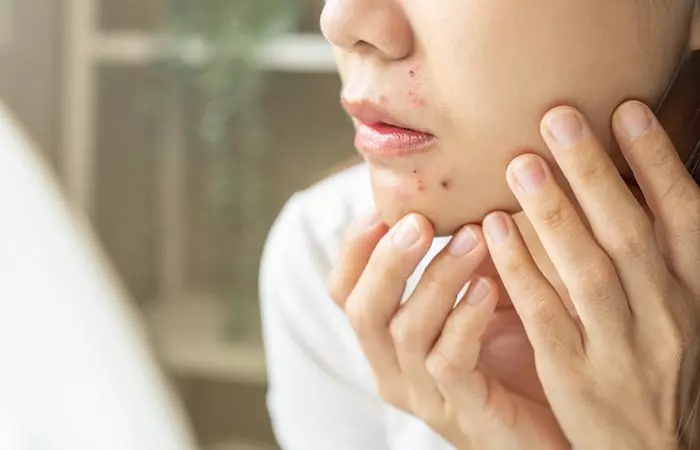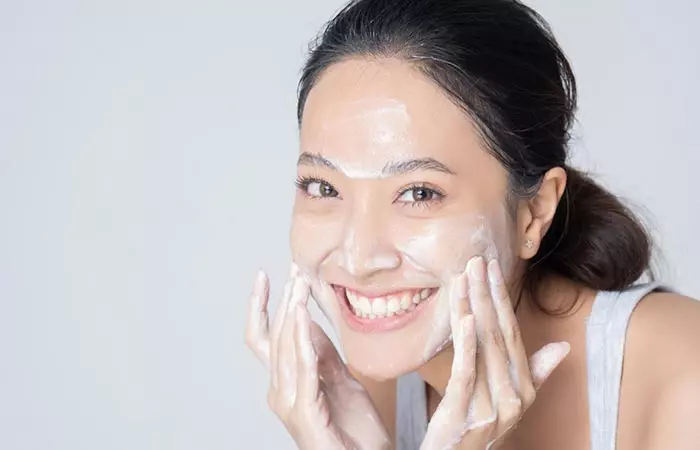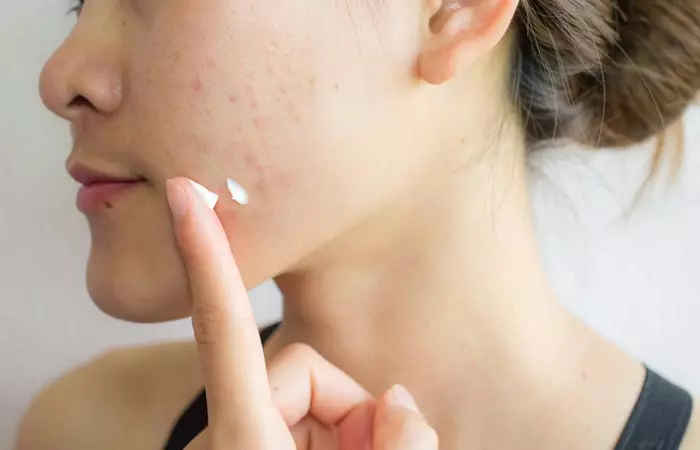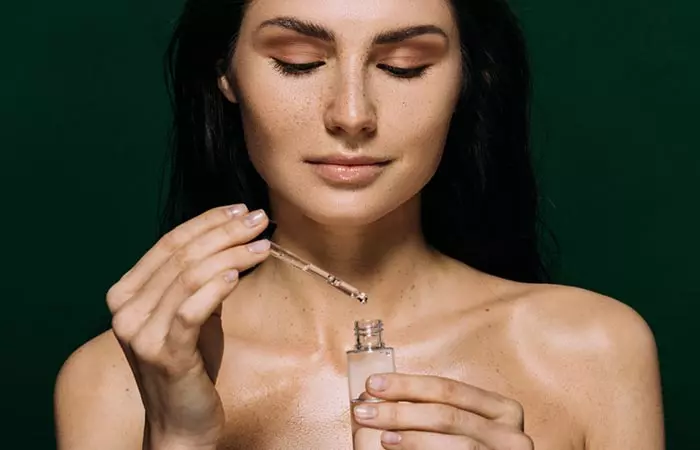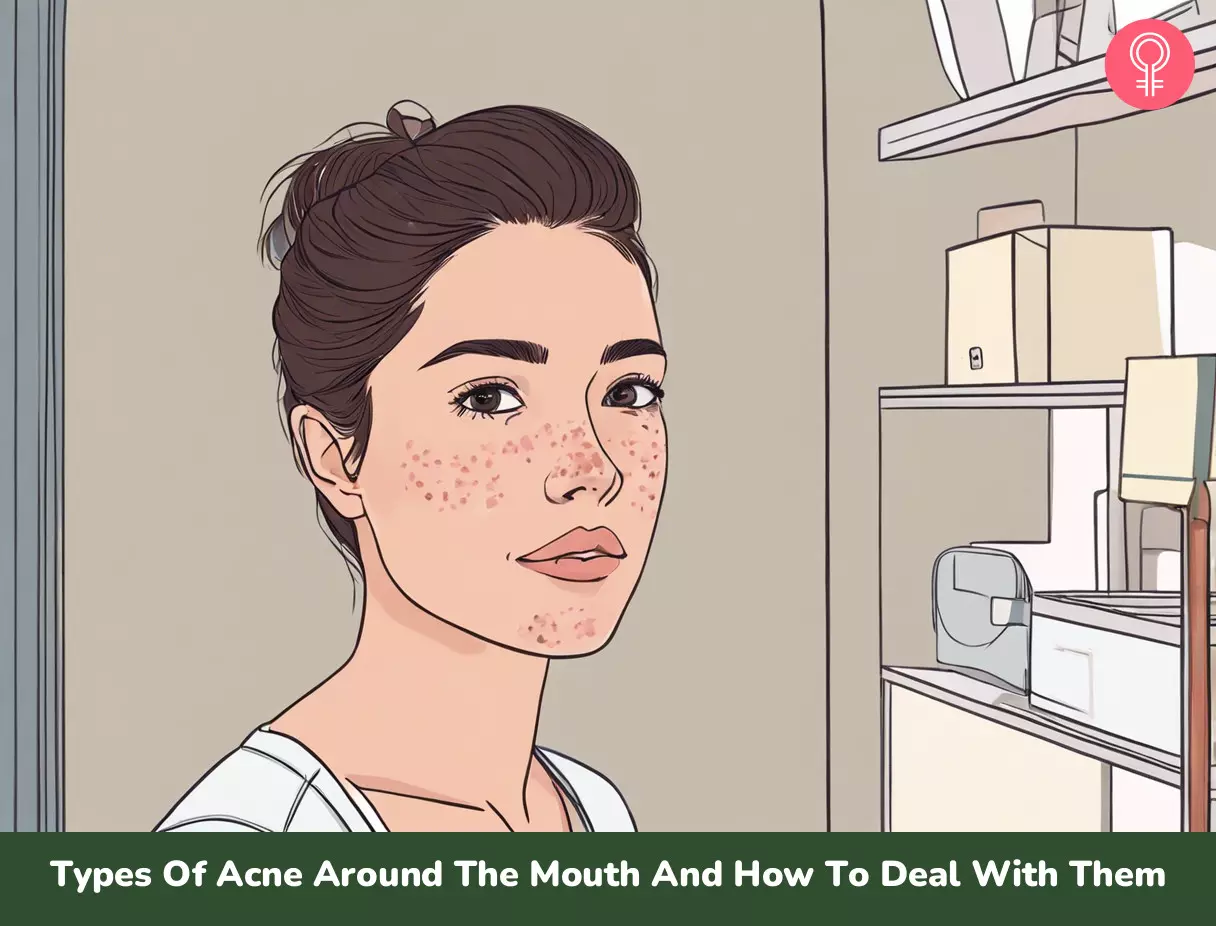Causes Of Acne Around The Mouth
Pin-pointing the cause of acne can help you find the solution to how to prevent acne. Acne or breakouts around the mouth occur when dirt, impurities, sebum, and acne-causing bacteria like P.acnes and S. aureus get trapped in your skin pores (1). You may notice more acne on your T-zone (the forehead, nose, mouth, and chin) as this area has more sebaceous glands than the rest of the face. Those who have oily skin are more prone to acne around their T-zone. However, if you are frequently breaking out around your mouth, there are many possible factors responsible for it:
You may experience both inflammatory and non-inflammatory lesions around your mouth. Let’s take a look at the types of breakouts that commonly occur in the area around your lips.
Types Of Breakouts Around The Mouth
1. Comedones
Did you notice small flesh-colored bumps around your mouth? Those are comedones – an early form of acne. These comedones can be open (called blackheads) or closed (known as whiteheads). Comedonal acne makes the skin look bumpy and rough (4).
2. Pustules And Papules
These are inflammatory acne and are painful. Papules and pustules are raised bumps with pus-filled heads. These may first appear as red and inflamed bumps and later develop pus. They are deep lesions and may also leave behind marks, blemishes, and scars (4). Dr. Line adds, “Sometimes, vesicles on the lips are due to herpes infection. These vesicles are usually more painful than common acne pimples.” Another skin condition, which is often mistaken as breakouts around the mouth, is perioral dermatitis. According to the American Academy Of Dermatology Association, these red rashes look like acne breakouts and cause itching and a burning sensation. Perioral dermatitis develops around the mouth and may also appear near the eyes and nose (5). This condition requires different treatment. If you notice redness and breakouts around your mouth, consult a dermatologist immediately.
How To Deal With Acne Around The Mouth
1. Follow Proper Cleansing Routine
A good skin care routine eliminates the chances of residue on the face and helps minimize the risk of inflammation. Washing your face twice a day and following up with a toner and moisturizer provides your skin with the basic care it needs. Remove all your makeup at the end of the day and double cleanse, if possible.
2. Use OTC Salicylic Acid Or Benzoyl Peroxide
Salicylic acid and benzoyl peroxide are proven OTC ingredients that help manage mild to moderate acne. You can use face washes, night creams, and serums containing these two ingredients. Salicylic acid encourages the skin’s natural exfoliation process, while benzoyl peroxide is a keratolytic agenti An agent that helps reduce bacterial growth and skin-irritating fatty acids to bind moisture to the skin. and exfoliates the upper layer of the skin to minimize acne (6).
3. Use Prescription Retinoid Products
Topical retinoids minimize comedone formation and prevent acne. For mild to moderate acne, you may use OTC retinol and isotretinoin products. Retinol can penetrate the skin better than tretinoin, although it is less potent (6). For severe acne, you must use prescription retinoid products. Consult a dermatologist for product recommendations.
4. Use Chemical Peels
Use a combination of alpha-hydroxy acids (and beta-hydroxy acids) to exfoliate your skin and remove the dead skin cells. You can use products containing glycolic, lactic, and mandelic, and salicylic acids. However, be careful while using chemical peels. If your skin is not accustomed to AHAs, start with the lowest lactic acid concentration (the mildest of all AHAs) and gradually increase the concentration. These are some ways to manage pimples and breakouts around the mouth. Apart from taking care of your skin externally, you must also check your diet and food habits.
What Foods Cause Acne Around The Mouth?
The link between diet and acne is still a matter of controversy. However, there are a few studies that link certain foods with the prevalence of acne. Foods that have a high glycemic index may worsen existing acne (2). So, avoid junk foods, fried foods, sugary beverages, goodies made of white flour, such as cookies, and cakes. These foods increase insulin levels and sebum production, contributing to acne formation. Also, avoid dairy foods as they may contain growth hormones, causing hormonal imbalance in your body and triggering acne (2). If possible, switch to organic and non-hormone milk and dairy products. At what age is acne the worst on the face? Acne can occur at any age and is likely to trouble you the most during your teenage and adolescent years. The onset of acne usually occurs when puberty hits. Does acne on the face go away naturally? No. Be it non-inflammatory or inflammatory acne, you have to take care of your skin and use topical products and ointments (if necessary) to minimize it. What is the hard and white stuff filled in acne around the mouth? The hard and white stuff in the acne may be sebum or pus, which contains waste residue, bacteria, and white blood cells. What does menopausal acne look like? Menopausal acne looks like hormonal acne – deep, tender bumps, mainly around the lips, chin, and jawline. Can low estrogen cause acne? Yes, a decrease in estrogen levels following menopause might cause acne in some women. How do I know if I have fungal acne? Excess yeast causes fungal acne, which can lead to whiteheads and itching. The acne also turns red, irritated, and inflamed. What do your pimples say about your health? Certain types of pimples such as cystic acne may denote underlying health issues like high blood pressure, dehydration, or digestive problems. Working on these underlying issues can often help treat the pimples.
Illustration: Types Of Acne Around The Mouth And How To Deal With Them
Learn more about what causes acne around the mouth and how to treat it. Check out this video to get answers to your questions and learn how to achieve clear skin.
